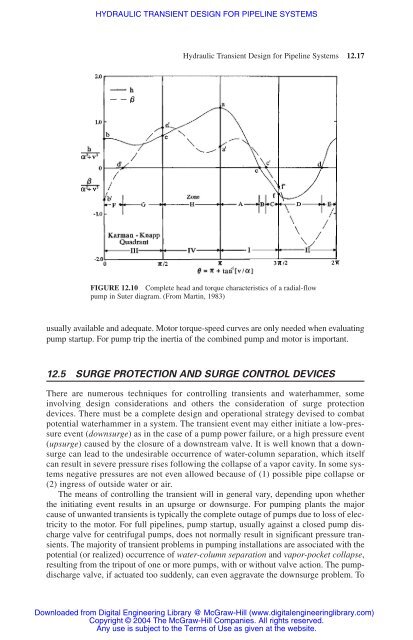chapter 12 hydraulic transient design for pipeline systems
chapter 12 hydraulic transient design for pipeline systems
chapter 12 hydraulic transient design for pipeline systems
You also want an ePaper? Increase the reach of your titles
YUMPU automatically turns print PDFs into web optimized ePapers that Google loves.
HYDRAULIC TRANSIENT DESIGN FOR PIPELINE SYSTEMS<br />
Hydraulic Transient Design <strong>for</strong> Pipeline Systems <strong>12</strong>.17<br />
FIGURE <strong>12</strong>.10 Complete head and torque characteristics of a radial-flow<br />
pump in Suter diagram. (From Martin, 1983)<br />
usually available and adequate. Motor torque-speed curves are only needed when evaluating<br />
pump startup. For pump trip the inertia of the combined pump and motor is important.<br />
<strong>12</strong>.5 SURGE PROTECTION AND SURGE CONTROL DEVICES<br />
There are numerous techniques <strong>for</strong> controlling <strong>transient</strong>s and waterhammer, some<br />
involving <strong>design</strong> considerations and others the consideration of surge protection<br />
devices. There must be a complete <strong>design</strong> and operational strategy devised to combat<br />
potential waterhammer in a system. The <strong>transient</strong> event may either initiate a low-pressure<br />
event (downsurge) as in the case of a pump power failure, or a high pressure event<br />
(upsurge) caused by the closure of a downstream valve. It is well known that a downsurge<br />
can lead to the undesirable occurrence of water-column separation, which itself<br />
can result in severe pressure rises following the collapse of a vapor cavity. In some <strong>systems</strong><br />
negative pressures are not even allowed because of (1) possible pipe collapse or<br />
(2) ingress of outside water or air.<br />
The means of controlling the <strong>transient</strong> will in general vary, depending upon whether<br />
the initiating event results in an upsurge or downsurge. For pumping plants the major<br />
cause of unwanted <strong>transient</strong>s is typically the complete outage of pumps due to loss of electricity<br />
to the motor. For full <strong>pipeline</strong>s, pump startup, usually against a closed pump discharge<br />
valve <strong>for</strong> centrifugal pumps, does not normally result in significant pressure <strong>transient</strong>s.<br />
The majority of <strong>transient</strong> problems in pumping installations are associated with the<br />
potential (or realized) occurrence of water-column separation and vapor-pocket collapse,<br />
resulting from the tripout of one or more pumps, with or without valve action. The pumpdischarge<br />
valve, if actuated too suddenly, can even aggravate the downsurge problem. To<br />
Downloaded from Digital Engineering Library @ McGraw-Hill (www.digitalengineeringlibrary.com)<br />
Copyright © 2004 The McGraw-Hill Companies. All rights reserved.<br />
Any use is subject to the Terms of Use as given at the website.
















